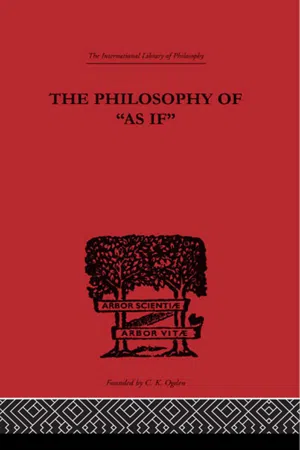
This is a test
- 416 pages
- English
- ePUB (mobile friendly)
- Available on iOS & Android
eBook - ePub
The Philosophy of As if
Book details
Table of contents
Citations
About This Book
First Published in 2000. Routledge is an imprint of Taylor & Francis, an informa company.
Frequently asked questions
At the moment all of our mobile-responsive ePub books are available to download via the app. Most of our PDFs are also available to download and we're working on making the final remaining ones downloadable now. Learn more here.
Both plans give you full access to the library and all of Perlego’s features. The only differences are the price and subscription period: With the annual plan you’ll save around 30% compared to 12 months on the monthly plan.
We are an online textbook subscription service, where you can get access to an entire online library for less than the price of a single book per month. With over 1 million books across 1000+ topics, we’ve got you covered! Learn more here.
Look out for the read-aloud symbol on your next book to see if you can listen to it. The read-aloud tool reads text aloud for you, highlighting the text as it is being read. You can pause it, speed it up and slow it down. Learn more here.
Yes, you can access The Philosophy of As if by H. Vaihinger in PDF and/or ePUB format, as well as other popular books in Philosophy & Philosophy History & Theory. We have over one million books available in our catalogue for you to explore.
Information
Table of contents
- COVER
- TITLE PAGE
- COPYRIGHT PAGE
- PREFACE
- AUTOBIOGRAPHICAL
- TABLE OF CONTENTS
- INTRO_CHAPTER I. —Thought, considered from the point of view ofa purposive organic Function.
- INTRO_CHAPTER II.—Thought as an Art, Logic as Technology.
- INTRO_CHAPTER III. —The Difference between the Artifices and Rules of Thought
- INTRO_CHAPTER IV. —The Transition to Fictions.
- PART I
- CHAPTER I.—Artificial Classification
- CHAPTER II.—Abstractive (Neglective) Fictions
- CHAPTER III.—Schematic, Paradigmatic, Utopian and Type Fictions
- CHAPTER IV.— Symbolic (Analogical) Fictions
- CHAPTER V.— Juristic Fictions
- CHAPTER VI.— Personificatory Fictions
- CHAPTER VII.— Summational Fictions
- CHAPTER VIII.— Heuristic Fictions
- CHAPTER IX.— Practical (Ethical) Fictions
- CHAPTER X.— The Fundamental Fictional Concepts of Mathematics
- CHAPTER XI.— The Method of Abstract Generalization
- CHAPTER XII.— The Method of Unjustified Transference
- CHAPTER XIII.— The Concept of Infinity
- CHAPTER XIV.— Matter and the Sensory World of Ideas
- CHAPTER XV.— The Atom as a Fiction
- CHAPTER XVI.— Fictions in Mechanics and Mathematical Physics
- CHAPTER XVII.— Things–in–themselves
- CHAPTER XVIII. —THE ABSOLUTE
- CHAPTER XIX. —Introductory Remarks on the Position of Fictions and Semi–fictions in the Logical System as a Whole
- CHAPTER XX.— The Separation of Scientific from other Fictions, particularly from the AEsthetic
- CHAPTER XXI.— The Difference between Fiction and Hypothesis
- CHAPTER XXII.— The Linguistic Form of the Fiction. Analysis of “As–if”
- CHAPTER XXIII.— Collection of Expressions for ‘Fiction’
- CHAPTER XXIV.— The Main Characteristics of Fictions
- CHAPTER XXV.— Outline of a General Theory of Fictional Constructs
- CHAPTER XXVI.— The Method of Correcting Arbitrary Differences or the Method of Antithetic Error
- CHAPTER XXVII.— The Law of Ideational Shifts
- CHAPTER XXVIII.—The Theory and Practice of Fictions
- CHAPTER XIX.— Beginnings of a Theory of Fictions among the Greeks
- CHAPTER XXX.— The Use of the Fiction among the Romans
- CHAPTER XXXI.— Beginnings of a Theory of Fictions among the Romans
- CHAPTER XXXII.— Medieval Terminology
- CHAPTER XXXIII.— The Use of Fictions in Modern Times
- CHAPTER XXXIV. —The Theory of Fictions in Modern Times
- CHAPTER XXXV. —The Basic Problem of the Theory of Know– ledge
- CHAPTER XXXVI.—The Falsification of Reality by the Logical Functions (Logical Optimism, Pessimism and Criticism)
- CHAPTER XXXVII.—Categories as Fictions (with a General Discussion of the Practical Purpose of Thought)
- CHAPTER XXXVIII. —Categories as Analogical Fictions
- CHAPTER XXXIX.—The Practical Utility of the Fiction of Categories
- § 1—Artificial Classification
- § 2—Further Artificial Classifications
- § 3—Adam Smith’s Method in Political Economy .
- § 4—Bentham’s Method in Political Science
- § 5—Abstractive Fictional Methods in Physics and Psychology
- § 6—Condillac’s Imaginary Statue
- § 7—Lotze’s ‘ Hypothetical Animal ‘.
- § 8—Other Examples of Fictitious Isolation
- § 9—The Fiction of Force
- § 10—Matter and Materialism as Mental Accessories
- § 11—Abstract Concepts as Fictions
- § 12—General Ideas as Fictions
- § 13—Summational, Nominal, and Substitutive Fictions
- § 14—Natural Forces and Natural Laws as Fictions
- § 15—Schematic Fictions
- § 16—Illustrative Fictions
- § 17—The Atomic Theory as a Fiction .
- § 18—Fictions in Mathematical Physics .
- § 19—The Fiction of Pure Absolute Space
- § 20—Surface, Line, Point, etc., as Fictions
- § 21—The Fiction of the Infinitely Small
- § 22—The History of the Infinitesimal Fiction .
- § 23—The Meaning of the ‘As If’ Approach
- § 24—The Fictive Judgment.
- § 25—The Fiction contrasted with the Hypothesis .
- I.—The Fundamental Elements in the principal Critical Works of Kant
- II.—Discussion of Principles in Kant’s Chief Works on Ethics and the Philosophy of Religion
- III.—Confirmations and Applications in the Other Works of the Critical Period (especially of 1790).
- IV.—Kant’s Posthumous Papers
- B.—FORBERG, THE ORIGINATOR OF THE FICHTEAN ATHEI8M–CONTROVERSY, AND HIS RELIGION OF AS–IF
- C.—LANGE’S “STANDPOINT OF THE IDEAL”.
- D.—NIETZSCHE AND HIS DOCTRINE OF CONSCIOUS ILLUSION(The Will to Illusion)
- Subject
- Index